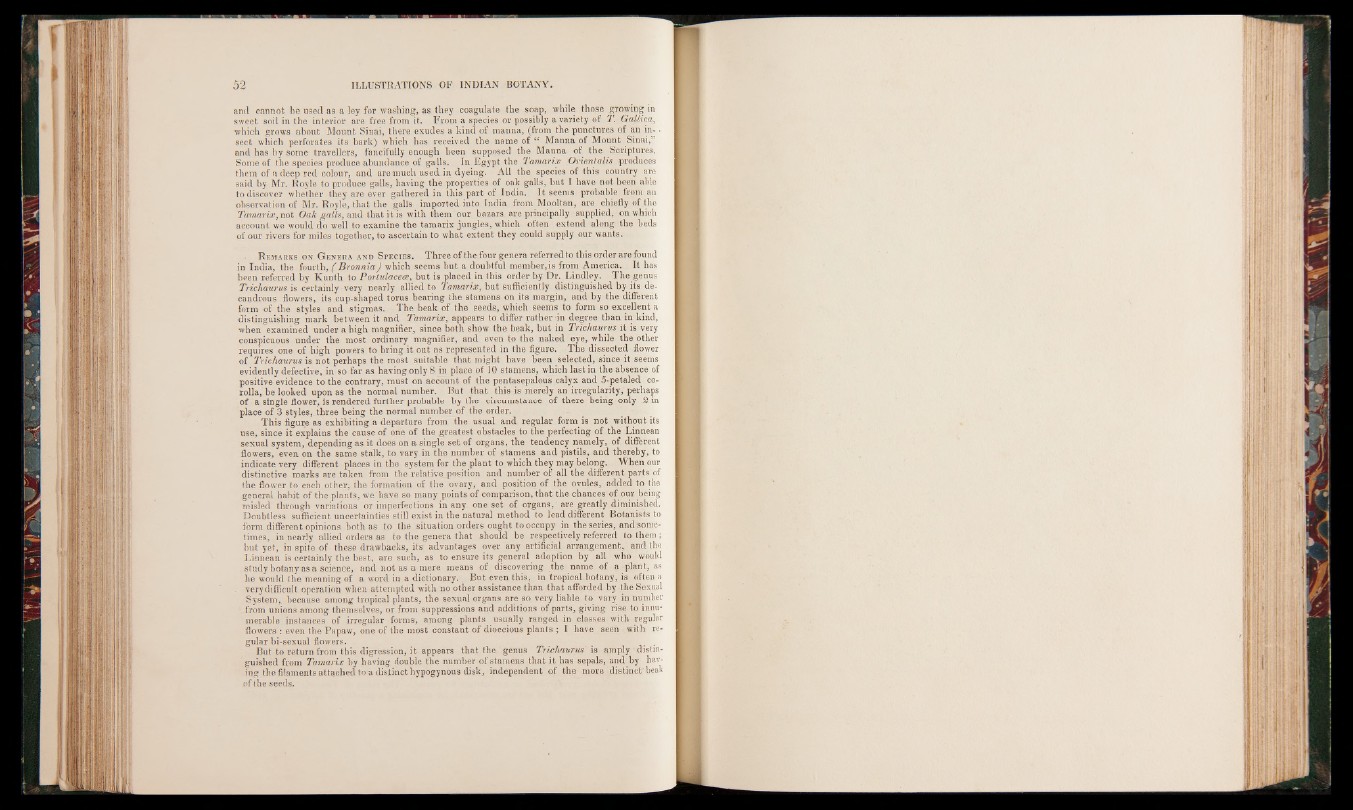
and cannot be used as a ley for washing, as they coagulate the soap, while those growing in
sweet soil in the interior are free from it. From a species or possibly a variety of T. Gallica,
which grows about Mount Sinai, there exudes a kind of manna, (from the punctures of an in- •
sect which perforates its bark) which has received the name of “ Manna of Mount Sinai,”
and has by some travellers, fancifully enough been supposed the Manna of the Scriptures.
Some of the species produce abundance of galls. In Egypt the Tamarix Orientalis produces
them of a deep red colour, and aremuch used in dyeing. All the species of this country are
said by Mr. Royle to produce galls, having the properties of oak galls, but I have not been able
to discover whether they are ever gathered in this part of India. It seems probable from an
observation of Mr. Royle, that the galls imported into India from Mooltan, are chiefly of the
Tamarix, not Oak galls, and that it is with them our bazars are principally supplied, on which
account we would do well to examine the tamarix jungles, which often extend along the beds
of our rivers for miles together, to ascertain to what extent they could supply our wants.
R emarks on G enera and Species. Three of the four genera referred to this order are found
in India, the fourth, ( Bronnia) which seems but a doubtful member,is from America. It has
been referred by Kunth to Portulacece, but is placed in this order by Dr. Lindley. The genus
Triehaurus is certainly very nearly allied to 7amarix, but sufficiently distinguished by its decandrous
flowers, its cup-shaped torus bearing the stamens on its margin, and by the different
form of the styles and stigmas. The beak of the seeds, which seems to form so excellent a
distinguishing mark between it and Tamarix, appears to differ rather in degree than in kind,
when examined under a high magnifier, since both show the beak, but in Trichaurus it is very
conspicuous under the most ordinary magnifier, and even to the naked eye, while the other
requires one of high powers to bring it out as represented in the figure. The dissected flower
of Trichaurus is not perhaps the most suitable that might have been selected, since it seems
evidently defective, in so far as having only 8 in place of 10 stamens, which last in the absence of
positive evidence to the contrary, must on account of the pentasepalous calyx and 5-petaled co*
rolla, be looked upon as the normal number. But that this is merely an irregularity, perhaps
of a single flower, is rendered further probable by the circumstance of there being only 2 in
place of 3 styles, three being the normal number^of the order.
This figure as exhibiting a departure from the usual and regular form is not without its
use, since it explains the cause of one of the greatest obstacles to the perfecting of the Linnean
sexual system, depending as it does on a single set of organs, the tendency namely, of different
flowers, even on the same stalk, to vary in the number of stamens and pistils, and thereby, to
indicate very different places in the system for the plant to which they may belong. When our
distinctive marks are taken from the relative position and number of all the different parts of
the flower to each other, the formation of the ovary* and position of the ovules, added to the
general habit of the plants, we have so many points of comparison, that the chances of our being
misled through variations or imperfections in any. one set of organs, are greatly diminished.
Doubtless sufficient uncertainties still exist in the natural method to lead different Botanists to
form different opinions both as to the situation orders ought to occupy in the series, and sometimes,
in pearly allied orders as to the genera that should be respectively referred to them;
but yet, in spite of these drawbacks, its advantages over any artificial arrangement, and the
Linnean is certainly the best, are such, as to ensure its general adoption by all who would
study botany as a science, and not as a mere means of discovering the name of a plant, as
he would the meaning of a word in a dictionary. . But even this, in tropical botany, is often a
. very difficult operation when attempted with no other assistance than that afforded by the Sexual
System, because among tropical plants, the sexual organs are so very liable to vary in number
. from unions among themselves, or from suppressions and additions of parts, giving rise to innumerable
instances of irregular forms, among plants usually ranged in classes with regular
flowers : even the Papaw, one of the most constant of dioecious plants j I have seen with regular
bi-sexual flowers. .
But to return from this digression, it appears that the genus Trichaurus' is amply ' distinguished
from Tamarix by having double the number of stamens that it has sepals, and by having
the filaments attached to a distinct bypogynous disk, independent of the more distinct" beak
of the seeds.